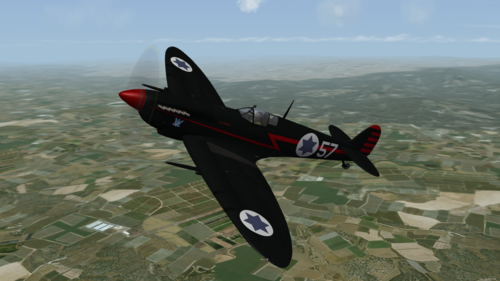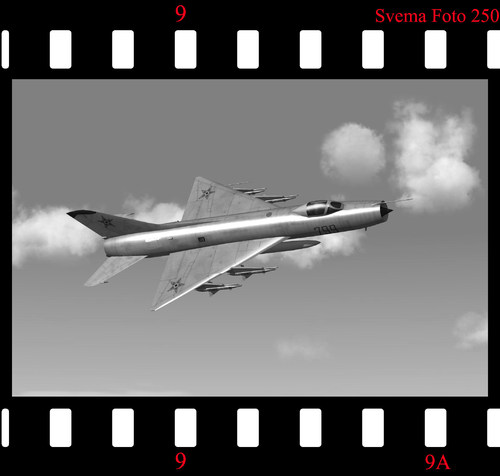-
Content count
9,300 -
Joined
-
Last visited
-
Days Won
497
Content Type
Profiles
Forums
Calendar
Gallery
Downloads
Store
Everything posted by Spinners
-

Strike Fighters 2 Screenshots Thread
Spinners replied to Wrench's topic in Thirdwire: Strike Fighters 2 Series - Screen Shots
Apex Predator -

Delta-Wing Mirage Screenshots
Spinners replied to Crusader's topic in Thirdwire: Strike Fighters 2 Series - Screen Shots
Runway, or another, I'm gonna get ya I'll get ya, I'll get ya, get ya, get ya, get ya -

Early Soviet Aggressors
Spinners posted a topic in Thirdwire: Strike Fighters 2 Series - Sci-Fi/Anime/What If Forum
Mikoyan-Gurevich MiG-17F "Fresco-C" - Unknown Aggressor Flight, Soviet Air Force, 1954 Camo Skin Credit: paulopanz- 2 replies
-
- 11
-

-

What If Screenshot Thread.......
Spinners replied to Dave's topic in Thirdwire: Strike Fighters 2 Series - Screen Shots
North American Shark FGA.1 - No.58 Squadron, RAF Middle East Command, 1960 -

What If Screenshot Thread.......
Spinners replied to Dave's topic in Thirdwire: Strike Fighters 2 Series - Screen Shots
1950's Soviet Aggressor! -

Little Rocket Man gets a Falcon from his friends
Spinners posted a topic in Thirdwire: Strike Fighters 2 Series - Sci-Fi/Anime/What If Forum
Hongdu L-15B Falcon - Korean People's Army Air Force, 2023 -

You're never too old to learn something new...
Spinners posted a topic in Thirdwire: Strike Fighters 2 Series - General Discussion
Well, that's a first! Just testing a random plane in SF2 Desert terrain and I took out the Comms Building with my 20mm cannon (GunTypeName=20MM_M61A1). -

What If Screenshot Thread.......
Spinners replied to Dave's topic in Thirdwire: Strike Fighters 2 Series - Screen Shots
Last Year's Model -

What If Screenshot Thread.......
Spinners replied to Dave's topic in Thirdwire: Strike Fighters 2 Series - Screen Shots
(Fin) Back in the USSR -
-

Strike Fighters 2 Screenshots Thread
Spinners replied to Wrench's topic in Thirdwire: Strike Fighters 2 Series - Screen Shots
Ezer Weizman’s Black Spitfire Nice one Toot! Long cannon barrel edited out. -

Dhimari Skyhawks
Spinners posted a topic in Thirdwire: Strike Fighters 2 Series - Sci-Fi/Anime/What If Forum
Douglas A-4D Skyhawk - No.7 Squadron (The Rattlesnakes), Royal Dhimari Air Force, 1977 During the early to mid-1950's almost every US Navy aircraft programme hit some sort of propulsion trouble with engines that were either down on thrust or simply so unreliable that they were a hazard to flight safety. Douglas were no exception and the SkyKnight and Skyray programmes were hit especially hard and the A4D Skyhawk programme initially didn't fare much better with the J65 down on thrust and the Pentagon bizarrely ordering that reconditioned Air Force J65's should be used for Skyhawk production. Ed Heinemann's wish to shoehorn the Rolls-Royce Avon into the Skyhawk fell apart when a production licence was granted to Westinghouse who then decided to only produce (with Navy funding but without telling Douglas ) a six-tenths scale version as the XJ64 giving less thrust than the J65! However, by 1955 the Navy BuWeps had decided to fund the promising Pratt & Whitney JT8, essentially a scaled-down JT3 or J57 and by 1957 the resultant J52 was running sweetly on the bench and Ed Heinemann could plan growth versions of his brilliant 'Bantam Bomber'. At about the same time the Navy were hinting that perhaps a more flexible machine was required than the high-altitude nuclear bomber of the original A4D requirement and the increased thrust of the J52 meant that two more stores pylons could be added and higher gross weights permitted. Douglas had planned to introduce the engine in the A4D-3 (A-4D) and A4D-5 (A-4E) variants but the US Navy cancelled the A4D-3 in 1959 and slowed the A4D-5 programme down. Douglas then looked at export opportunities resurrecting the A4D-3 designation to produce a multi-role fighter version later designated the A-4D which introduced the new J52 engine rated at 8,500lbs thrust plus a small and simple multi-mode radar. Oil-rich Dhimar became the launch customer ordering 60 A-4D's in 1961 and these were delivered in early 1963 initially to No.7 Squadron of the Dhimari Air Force who operated the type until 1982. Skin Credit: salvatorestupido- 1 reply
-
- 7
-

-

What If Screenshot Thread.......
Spinners replied to Dave's topic in Thirdwire: Strike Fighters 2 Series - Screen Shots
Mongolian Fishpots -

[Fictional] Su-9PF 'Fishpot-A' for WarPac Nations
Spinners posted a topic in Thirdwire: Strike Fighters 2 Series - File Announcements
View File [Fictional] Su-9PF 'Fishpot-A' for WarPac Nations Sukhoi Su-9PF 'Fishpot-A' for STRIKE FIGHTERS 2 This is a simple mod of the stock Su-9 interceptor to create a fictional Su-9PF in service with the Warsaw Pact air forces of Bulgaria, Czechoslovakia, East Germany, Hungary, Poland, Romania and the USSR in an overall 1961-1983 timeline. The skins and markings are pretty generic and mainly use stock Third Wire stuff but I did create some new number decals for the Bulgarian, Hungarian and Romanian aircraft. I decided not make a skin for Albania as it was not part of the contiguous border between east and west and, in any case, it quit the Warsaw Pact in 1968. INSTRUCTIONS 1. From the AIRCRAFT folder drag and drop the Su-9PF folder into your Aircraft folder. 2. From the DECALS folder drag and drop the Su-9PF folder into your Decals folder. 3. From the WEAPONS folder drag and drop the AA-1B2 folder into your Weapons folder. That's it! The AA-1B2 is a cloned 'Alkali' missile that I've altered simply to allow it to be carried by the WarPac nations - it's a pretty useless missile but I decided not to perk it up. But, for gameplay reasons, I've added guns to the Su-9PF with a simple edit that you can reverse. CREDITS As always, thanks to Third Wire for a great little game/sim. Special thanks to Stary for the Su-9 cockpit. And, finally, thanks to everyone in the wider Third Wire community. Regards Spinners Version 1 - November 4th, 2023 Submitter Spinners Submitted 11/04/2023 Category What If Hangar -
Version 1.0.0
75 downloads
Sukhoi Su-9PF 'Fishpot-A' for STRIKE FIGHTERS 2 This is a simple mod of the stock Su-9 interceptor to create a fictional Su-9PF in service with the Warsaw Pact air forces of Bulgaria, Czechoslovakia, East Germany, Hungary, Poland, Romania and the USSR in an overall 1961-1983 timeline. The skins and markings are pretty generic and mainly use stock Third Wire stuff but I did create some new number decals for the Bulgarian, Hungarian and Romanian aircraft. I decided not make a skin for Albania as it was not part of the contiguous border between east and west and, in any case, it quit the Warsaw Pact in 1968. INSTRUCTIONS 1. From the AIRCRAFT folder drag and drop the Su-9PF folder into your Aircraft folder. 2. From the DECALS folder drag and drop the Su-9PF folder into your Decals folder. 3. From the WEAPONS folder drag and drop the AA-1B2 folder into your Weapons folder. That's it! The AA-1B2 is a cloned 'Alkali' missile that I've altered simply to allow it to be carried by the WarPac nations - it's a pretty useless missile but I decided not to perk it up. But, for gameplay reasons, I've added guns to the Su-9PF with a simple edit that you can reverse. CREDITS As always, thanks to Third Wire for a great little game/sim. Special thanks to Stary for the Su-9 cockpit. And, finally, thanks to everyone in the wider Third Wire community. Regards Spinners Version 1 - November 4th, 2023 -

What If Screenshot Thread.......
Spinners replied to Dave's topic in Thirdwire: Strike Fighters 2 Series - Screen Shots
SHIPFOT! (Scrambled Fishpot) -

The Supermarine Syrena in RAF Service
Spinners posted a topic in Thirdwire: Strike Fighters 2 Series - Sci-Fi/Anime/What If Forum
-

What If Screenshot Thread.......
Spinners replied to Dave's topic in Thirdwire: Strike Fighters 2 Series - Screen Shots
Supermarine Syrena F.1 - No.111 Squadron, RAF Fighter Command, 1962 -

The Supermarine Syrena in RAF Service
Spinners replied to Spinners's topic in Thirdwire: Strike Fighters 2 Series - Sci-Fi/Anime/What If Forum
Only the F.1 at the top. The bottom four are ground-attack. -

What If Screenshot Thread.......
Spinners replied to Dave's topic in Thirdwire: Strike Fighters 2 Series - Screen Shots
South Atlantic Badgers -

What If Screenshot Thread.......
Spinners replied to Dave's topic in Thirdwire: Strike Fighters 2 Series - Screen Shots
Supermarine Syrena F.1 - No.145 Squadron, RAF Fighter Command, 1963 -

What If Screenshot Thread.......
Spinners replied to Dave's topic in Thirdwire: Strike Fighters 2 Series - Screen Shots
Follow That Camel -

Iberian Meteors
Spinners replied to Spinners's topic in Thirdwire: Strike Fighters 2 Series - Sci-Fi/Anime/What If Forum
Revised upload!- 1 reply
-
- 1
-

-

Iberian Meteors
Spinners posted a topic in Thirdwire: Strike Fighters 2 Series - Sci-Fi/Anime/What If Forum
- 1 reply
-
- 4
-






